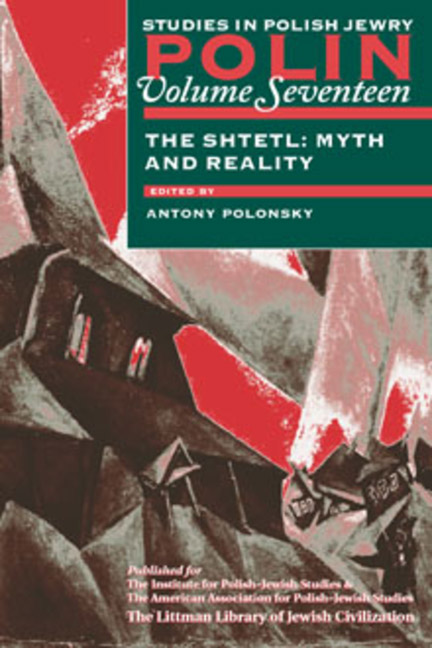Book contents
- Frontmatter
- Dedication
- Editors and Advisers
- Preface
- Polin
- Polin: Studies inPolish Jewry
- Contents
- Note on Place Names
- Note on Transliteration
- List of Abbreviations
- PART I THE SHTETL: MYTH AND REALITY
- Introduction. The Shtetl: Myth and Reality
- The Shtetl as an Arena for Polish–Jewish Integration in the Eighteenth Century
- Inter-Religious Contacts in the Shtetl: Proposals for Future Research
- The Hasidic Conquest of Small-Town Central Poland, 1754–1818
- The Drama of Berdichev: Levi Yitshak and his Town
- Polish Shtetls under Russian Rule, 1772–1914
- How Jewish Was the Shtetl?
- The Changing Shtetl in the Kingdom of Poland during the First World War
- The Shtetl: Cultural Evolution in Small Jewish Towns
- Small Towns in Inter-War Poland
- Jewish Patrons and Polish Clients: Patronage in a Small Galician Town
- Maintaining Borders, Crossing Borders: Social Relationships in the Shtetl
- The Soviet Shtetl in the 1920s
- Shtetl and Shtot in Yiddish Haskalah Drama
- Kazimierz on the Vistula: Polish Literary Portrayals of the Shtetl
- Imagining the Image: Interpretations of the Shtetl in Yiddish Literary Criticism
- Shtetl Codes: Fantasy in the Fiction of Asch, Schulz, and I. B. Singer
- Returning to the Shtetl: Differing Perceptions
- PART II NEW VIEWS
- PART III DOCUMENTS
- PART IV THE SIXTY-FIFTH ANNIVERSARY OF EVENTS IN PRZYTYK: A DEBATE
- PART V REVIEWS
- OBITUARIES
- Notes on the Contributors
- Glossary
- Index
The Hasidic Conquest of Small-Town Central Poland, 1754–1818
from PART I - THE SHTETL: MYTH AND REALITY
- Frontmatter
- Dedication
- Editors and Advisers
- Preface
- Polin
- Polin: Studies inPolish Jewry
- Contents
- Note on Place Names
- Note on Transliteration
- List of Abbreviations
- PART I THE SHTETL: MYTH AND REALITY
- Introduction. The Shtetl: Myth and Reality
- The Shtetl as an Arena for Polish–Jewish Integration in the Eighteenth Century
- Inter-Religious Contacts in the Shtetl: Proposals for Future Research
- The Hasidic Conquest of Small-Town Central Poland, 1754–1818
- The Drama of Berdichev: Levi Yitshak and his Town
- Polish Shtetls under Russian Rule, 1772–1914
- How Jewish Was the Shtetl?
- The Changing Shtetl in the Kingdom of Poland during the First World War
- The Shtetl: Cultural Evolution in Small Jewish Towns
- Small Towns in Inter-War Poland
- Jewish Patrons and Polish Clients: Patronage in a Small Galician Town
- Maintaining Borders, Crossing Borders: Social Relationships in the Shtetl
- The Soviet Shtetl in the 1920s
- Shtetl and Shtot in Yiddish Haskalah Drama
- Kazimierz on the Vistula: Polish Literary Portrayals of the Shtetl
- Imagining the Image: Interpretations of the Shtetl in Yiddish Literary Criticism
- Shtetl Codes: Fantasy in the Fiction of Asch, Schulz, and I. B. Singer
- Returning to the Shtetl: Differing Perceptions
- PART II NEW VIEWS
- PART III DOCUMENTS
- PART IV THE SIXTY-FIFTH ANNIVERSARY OF EVENTS IN PRZYTYK: A DEBATE
- PART V REVIEWS
- OBITUARIES
- Notes on the Contributors
- Glossary
- Index
Summary
… that small and intellectually meagre town, a town which the hasidim conquered and converted and abolished all the old customs, a town whose synagogue was closed and locked during all six months of winter … and the liturgy was mixed and muddled with every other liturgy, the doing of the new hasidim, and even the synagogue was looted and the old liturgy completely abolished from there by force— upon my arrival in that town, I too was dragged into the custom of the town's inhabitants and forced to pray in the beit midrash according to the liturgy of drunks: the Sefarad liturgy.
(ABRAHAM BAER GOTTLOBER, Zikhronot umasaot)ONE of the more remarkable phenomena in the east European Jewish past was the triumph of hasidism, a mystical revival sparked during the mid-eighteenth century by the disciples of Israel Ba'al Shem Tov (the Besht, c. 1700–60). As those disciples began to buttress their master's doctrine of popular mysticism with palpable social and political power, they discovered that certain spiritual concepts could be expanded to accommodate and justify their roles as leaders in the mundane sphere. By the first decades of the nineteenth century, hasidism—now as much a sociopolitical innovation as a religious one—had emerged as a mass movement. It had won such overwhelming support that, in terms of sheer influence, hasidism deserves to be recognized as the most important phenomenon in modern east European Jewish history before the rise of the new Jewish politics at the end of the nineteenth century.
For all the scholarly attention dedicated to hasidism's origins, our understanding of its transformation into a thriving mass movement remains fragmentary and highly theoretical. While its origins have been well documented, hasidism as an emergent mass movement at the turn of the nineteenth century awaits comprehensive and systematic historical treatment. The scope of Moshe Rosman's groundbreaking and exhaustive look at the Besht and his circle within their historical context is limited to the lifetime of hasidism's founder alone.
- Type
- Chapter
- Information
- The Shtetl: Myth and Reality , pp. 51 - 82Publisher: Liverpool University PressPrint publication year: 2004



